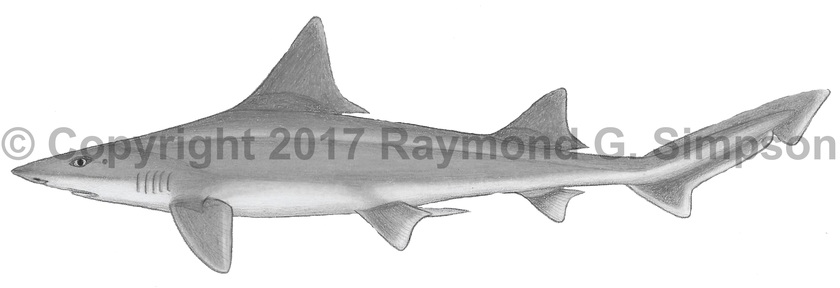
Common Name
Gulf Smoothhound
Year Described
Heemstra, 1997
Identification
A small and slender shark with two large dorsal fins. Back more hunched than sympatric Mustelus canis and M. norrisi. Mouth with labial furrows equal in length. Teeth small and low with stumpy cusps. Eye large with a prominent spiracle less than eye diameter behind it. Nostril with projecting tabs. Distance between nostrils 2.6-3.3% TL. Dorsal fins lack spines. Second dorsal fin about 50% as high as the first. First dorsal twice the size of second: origin over rear base of pectoral fin. Second dorsal fin origin anterior to anal fin origin but well behind pelvic free tip. Pectoral fin angular. Pelvic and anal fins much smaller than second dorsal fin. No precaudal pits. Caudal fin with a prominent rounded lower lobe. Skin with overlapping tri-pointed denticles with 3 parallel ridges. Precaudal vertebrae: 68-71.
Color
Body uniformly gray to gray-brown above grading to pure white or cream below. No spots or markings on body.
Size
Maximum size to 140cm TL. Mature adults over 80cm TL.
Habitat
Taken in deeper waters than related sympatric species: depth range is stated as 36-229m.
Range
Appears to be endemic to the Gulf of Mexico (Florida to the Yucatan Peninsula).
References
Castro, J.I. 2011. The Sharks of North America. Oxford University Press, 640 pp.
Compagno, L., M. Dando, and S. Fowler. 2005. Sharks of the World. Princeton University Press, 480 pp.
Heemstra, P.C. 1997. A review of the smooth-hound sharks (genus Mustelus, family Triakidae) of the western Atlantic Ocean, with descriptions of two new species and a new subspecies. Bulletin of Marine Science, 60(3), 894-928.
Other Notes
Quite distinct from Mustelus canis and M. norrisi on several characters, including denticle morphology, precaudal vertebrae, size of dorsal fin, and noticeably humped dorsum. It largely replaces these species in deeper waters over 20m.